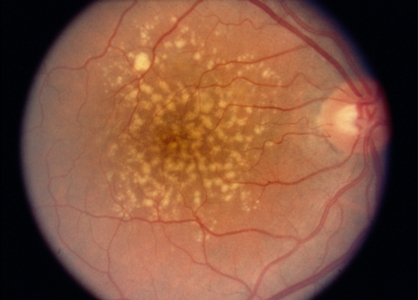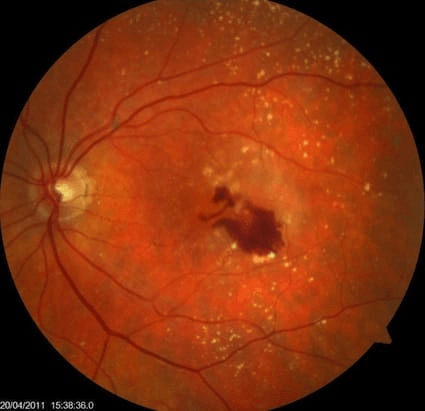Call Today! (419) 521-3937 (EYES) or Toll Free: (888) 549-3937 (EYES) | Find Us
Macular Degeneration
What is Macular Degeneration?
Symptoms to Watch For
- Blurry vision at distance or near
- Objects look different sizes in one eye compared to the other
- Distortion: straight lines appear crooked or bent
- Dark gray or blank area in the center of vision
- Disparity of color in one eye compared to the other
Risk Factors
- Older than 50 years
- Positive family history of AMD
- Smoking cigarettes
Types of Macular Degeneration

Age-related Macular Degeneration
There are many types of macular degeneration, but the most commonly seen conditions are those associated with the aging process, and referred to as age-related macular degeneration (AMD).

Dry Macular Degeneration
Occurs when deposits (yellow or white pieces of fatty protein) form under the retina. Over time the retina thins and doesn’t function properly. Most cases of AMD are of the dry form. Patients who have been diagnosed with dry AMD need to carefully monitor their vision for changes using an Amsler grid daily; changes may an indication that the dry form has progressed to the more severe exudative type.

Wet Macular Degeneration
Results when abnormal blood vessels grow underneath the retina from a layer of the retina known as the choroid. This new growth is referred to as choroidal neovascularization (CNV). These vessels can leak fluid or blood, and interfere with the central vision. This type of AMD can happen quickly, and cause more significant loss of vision than the dry form. Early diagnosis and treatment improves the chance of preserving vision; the longer these vessels leak or grow, the higher the risk of visual loss. If this occurs in one eye, it increases the risk of occurrence in the fellow eye. Close monitoring of your vision with the Amsler grid is very important to the over-all management of this condition. Any changes you see should be reported to our office immediately.
Amsler Grid
- Cover one eye at a time
- Keeping your eye focused on the center dot, without looking away from it, note whether you see any wavy or distorted areas, or if there are any missing parts.
- Check the other eye
Treatment Options
- Drugs to inhibit abnormal blood vessel growth
- Laser surgery
- Photodynamic therapy (PDT)
Ready to Get Started?
Contact Us Today!
Contact Us
We will get back to you as soon as possible.
Please try again later.
Sat-Sun: Closed
© 2019 Advanced Eye Care & Surgery Center. All Rights Reserved.



